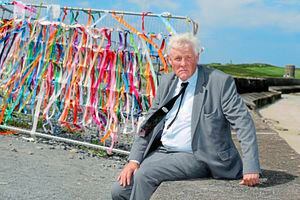Expert warns of repair legacy if wall is left
‘A LEGACY of continuous work’ will be inherited by generations to come if no action is taken on the most damaged sections of the L’Ancresse anti-tank wall, engineering consultancy firm Royal HaskoningDHV has warned.

Environment & Infrastructure’s preferred plan for a 200m stretch of the wall is to remove part of the wall and build two protective rock groynes, allowing natural sand dunes to form.
Greg Guthrie, from the engineering firm, showed deputies around the affected area yesterday morning to answer questions about the state of the wall.
He said this part of the wall had moved ‘too far forward’ and that a programme of ongoing repairs was not a long-term solution.
‘It is possible to halt this line by reconstructing the wall, by putting steel sheets in with a concrete apron where there are cracks.’
Groups such as Festung Guernsey and the Vale Commons Council have highlighted the wall’s heritage as one reason to maintain it in its entirety.
‘However, if we were to maintain it in this way it would not be the same wall, it would be a new wall,’ Mr Guthrie said.
He said these and any other repair works that could be applied were not lasting solutions, which the island should be looking for.
Another issue with this is that the remaining anti-tank wall to the west would be at risk from water ingress behind it.
‘We would be leaving ourselves a legacy of continuous work in the future. When the opportunity arises we have to think what future we want to create,’ he said.
Mr Guthrie said removing this section of wall would undoubtedly cause the coastline to move back, but said the two groynes would help to manage the recess of the coastline.
‘We have assessed the width and how far the coast will reach without the wall, we have analysed data collected from the last 20 years and are predicting that the crest of the coastline is likely to be set back up to 30 metres,’ he said.
Committee president Deputy Barry Brehaut said that, aside from E&I members, 10 deputies had attended.
He said it was important to give them a platform to fully understand and weigh up the pros and cons of the options laid out in the committee’s policy letter.
